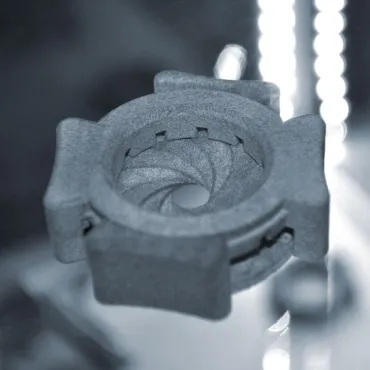Bringing ideas to life, one layer at a time
MJF (Multi Jet Fusion)
MJF
Multi Jet Fusion (MJF) stands out among 3D printing technologies for its exceptional capabilities. This advanced method offers substantial advantages, including high printing speeds that significantly reduce production times. MJF facilitates the concurrent printing of multiple parts, enhancing overall efficiency and throughput. The technology excels in producing parts that boast high-resolution detail, smooth surface finishes, and robust mechanical properties, making it ideal for a wide range of applications—from rapid prototyping to full-scale production.
Furthermore, Multi Jet Fusion is a highly versatile and efficient technology that has been successfully integrated into various sectors. Industries such as automotive, aerospace, healthcare, and consumer goods have benefited from its ability to quickly and reliably produce complex, durable components. MJF’s adaptability and precision continue to drive innovation and efficiency across these diverse fields, underscoring its importance in the evolving landscape of additive manufacturing.
Furthermore, Multi Jet Fusion is a highly versatile and efficient technology that has been successfully integrated into various sectors. Industries such as automotive, aerospace, healthcare, and consumer goods have benefited from its ability to quickly and reliably produce complex, durable components. MJF’s adaptability and precision continue to drive innovation and efficiency across these diverse fields, underscoring its importance in the evolving landscape of additive manufacturing.


Materials
PA12


Process Flow :
3D Model Preparation
The first step involves creating or obtaining a 3D model of the desired object. This can be done using computer-aided design (CAD) software or by obtaining a pre-existing model.
Slicing the Model
The 3D model is sliced into thin cross-sectional layers using slicing software. Each layer represents a specific height of the final object.
Preparing the Printer
The MJF printer is prepared by ensuring that the build platform is clean and properly aligned. The printer is also loaded with the appropriate materials, which typically include a powdered material (e.g., nylon-based thermoplastic) and the fusing agent.
Spreading the Powder
A thin layer of powdered material is evenly spread across the build platform. The thickness of this layer depends on the desired resolution and properties of the final object.
Inkjet Printing
A carriage containing multiple inkjet print heads moves over the powder bed. The print heads deposit the fusing agent and detailing agent onto the powdered material in a selective manner based on the sliced data.
a. Fusing Agent: The fusing agent is applied to specific areas of each layer where fusion is desired. It is an infrared-absorbing material that will later be heated to fuse the powdered material together. b. Detailing Agent: The detailing agent is applied to enhance the accuracy and resolution of the printed part. It helps to define fine features and improve surface finish.
Fusion and Cooling
After the inkjet printing stage, the powder bed moves to a heating unit or an array of infrared lamps. The heat causes the fusing agent to absorb energy and melt, which fuses the adjacent powdered material particles together. This fusion process creates solid layers.a. Cooling: Once a layer is fused, the heating source moves on, and the newly formed layer begins to cool down. Cooling is essential to ensure the layers retain their structural integrity.
Layer-by-Layer Building
Steps 5 and 6 are repeated for each subsequent layer, with a new layer of powder spread on top of the previously fused layer. This layer-by-layer process continues until the entire object is built.
Post-Processing
Once the printing is completed, the printed object remains embedded in the powder bed. Post-processing involves carefully removing the printed object from the bed and removing excess powder. The object may undergo additional treatments, such as bead blasting, to further enhance its surface finish if desired.
Finishing and Quality Control:
The printed object may undergo additional finishing processes, such as sanding, polishing, or painting, to achieve the desired aesthetics and functional requirements. Quality control checks can also be performed to ensure dimensional accuracy and structural integrity.
Advantages :
Speed
MJF is known for its high print speeds. The inkjet printing process used in MJF allows for the simultaneous deposition of multiple agents, which speeds up the fabrication process. This makes MJF an efficient option for both prototyping and production applications.
Accuracy and Detail
MJF can produce parts with high accuracy and fine details. The inkjet print heads deposit a detailing agent that enhances the resolution and surface finish of the printed objects. This makes MJF suitable for creating intricate and complex geometries.
High Volumetric Efficiency
MJF achieves high volumetric efficiency by leveraging the powder bed fusion process. The unused powder in the bed can be reused for subsequent prints, resulting in minimal material waste. This efficiency is particularly advantageous for cost-effective production runs.
Functional Parts
MJF produces functional parts with good mechanical properties. The fusion of the powdered material using a fusing agent results in robust and durable parts. The printed objects exhibit isotropic properties, meaning they have consistent strength and performance in all directions.
Versatility of Materials
MJF supports a wide range of materials, with the most common being nylon-based thermoplastics. These materials offer excellent mechanical properties, such as strength, flexibility, and heat resistance. The ability to use different materials allows for a variety of applications across various industries.
Scalability
MJF is highly scalable due to its ability to simultaneously print multiple parts in a single build. This feature enables efficient batch production, reducing lead times and increasing productivity. It is particularly advantageous for industries that require large volumes of parts, such as automotive or consumer goods.
Innovative Additive Manufacturing Solutions by RIFTWAY SOLUTIONS
On-Demand manufacturing offers industries flexibility, cost reduction, customization, sustainability and simplifying the supply chain
